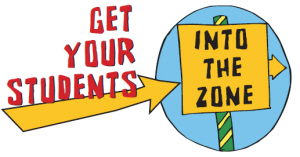Get Your Students Into the Zone
Everyone wants to be in the zone. The zone is this magical, mystical place in which you feel so confident, your focus is so sharp and your emotions are completely calm. The zone is being at your best in whatever you are accomplishing. It would be wonderful if we can help our students to get into the zone as much as possible on the golf course.
Here are two easy steps to helping students to get into zone more often:
1. Become aware of their zone experience. Your students need to be aware of which emotions occur during the zone experience.
2. Emotionally prepare for the zone state. Your students will need to develop a personalized routine that will help them get into the zone more often.
The zone experience is unique to everyone. Some individuals may be highly anxious when they are in the zone, while others can be very calm. Some individuals will be thinking a lot when they get into the zone, while other individuals have a clear mind. There is not one set pattern of emotions. Thus, our students need to be aware of their individualized zone template. This process is known as self-monitoring and is essential to developing a clear understanding of their zone experience.
To help your students become aware of their zone template, the instructor needs to have the student address two different situations. First, ask your students to recall a time when they performed at their best. Then, the teacher should ask the following questions related to five levels of this particular “best” performance state:
1. Was your nervousness level-high, medium, or low?
2. Was your confidence level- high, medium, or low?
3. Was your energy level-high, medium, or low?
4. Was your enjoyment level- high, medium, or low?
5. Where you thinking or just reacting?
To develop a better understanding of the zone state for your students, the teacher should ask a question about the contrasting situation. Students should recall a time when they performed at their worst. Again, this can be in the sport of interest or in a different performance situation. The teacher should also address the same five levels of this “worst” performance state:
1. Was your nervousness level high, medium, or low?
2. Was your confidence level high, medium, or low?
3. Was your energy level high, medium, or low?
4. Was your enjoyment level high, medium, or low?
5. Where you thinking or reacting?
These two sets of questions concerning contrasting performance situations – best vs. worst – will give teachers all the information they need to understand their students at a deeper level. For instance, some students may perform at their best when they have low energy and at their worst with high energy, while a different student may be at their best with high energy and at their worst when their energy is low. Or, one student may be best when they are reacting and perform at their lowest when they think too much while a different student follows the opposite pattern. Gaining knowledge about best vs. worst performance is essential before moving to the next step.
Emotionally preparing for their zone state:
The next step of this process is to replicate the emotions of the zone state for the student. There are three ways to help your student accomplish this:
1. Create an emotional buzzword that represents that zone state
2. Create a behavior trigger associated with that zone state
3. Use a visual image that represents that zone state.
Emotional buzzwords help to elicit the same emotions that the student felt during their zone state. As an example, I had a high school golfer, Ron, describe his zone state to me. When he described it to me, he said he felt extremely aggressive and confident, like nothing could shake him. When he performed at his worst, he felt he lost confidence, as well as he was very passive, with low energy. I suggested the cue word “bulldog” and he loved it. Ron said that is exactly how he felt at his best, like an aggressive bulldog on the mound.
I then asked Ron to describe how a bulldog would feel. He said that a bulldog would always keep his head high. So for Ron, we created the behavior trigger of “chin up.” I then asked Ron of a visual image that reminded of him when he was confident and aggressive. He said he had a picture of him smashing one of his longest drives. I told him to put his picture on his phone (he had one of those fancy i-phones), and to look at this picture as much as possible. But more importantly, when he looks at this picture, Ron is to recall feelings of confidence.
The last step is to create a personalized routine. That is, Ron is to put all three processes (buzzword, behavioral trigger, and image) into his pre-shot routine. Specifically, at the start of Ron’s routine, he is to say “bulldog.” As he says this, he is to get his chin up, and then he is to recall that image of him smashing that long drive. All three will help him instantly get into the correctional emotional state for his upcoming shot.
To help your students play at their best, help them become aware of their best (zone) state and then help your students create a personalized routine that will lead to their most effective emotions. This is a simple but incredibly powerful method that will lead to your students playing their best golf.





